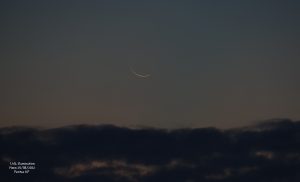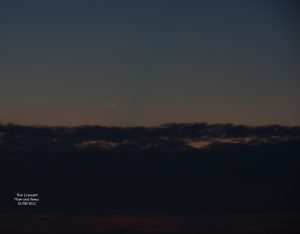The Moon & Jupiter on the 8th October 2022 taken by member Jim Burchell using a Pentax KP camera.
Jupiter is top left of the Moon in the photo.
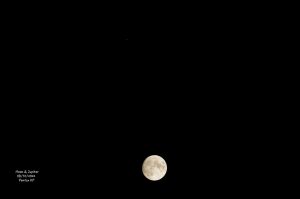
Astronomy every Thursday
This category will show a few lines from the last 3 items on the home page.
It will also show the full post on the news page
The Moon & Jupiter on the 8th October 2022 taken by member Jim Burchell using a Pentax KP camera.
Jupiter is top left of the Moon in the photo.

Three more sets of observations of exoplanet transits for the ExoClock project by Simon Dawes. WASP-52b, Qatar-1b and HAT-P-6b.
WASP-52 b is a gas giant exoplanet that orbits a K-type star. Its mass is 0.46 Jupiters. Exoplanet WASP-52b orbits at a distance of 4.07 million km from its host star WASP-52, taking 1.75 days to go round its orbit. Its discovery in the constellation Pegasus was announced in 2012.
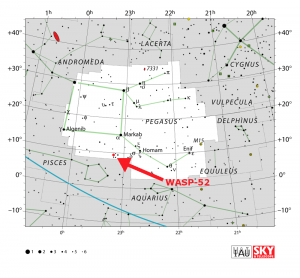
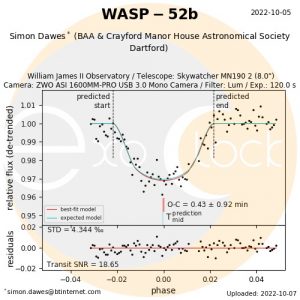
Qatar-1 b is a gas giant exoplanet that orbits a metal-rich K-dwarf star, which is one of the faintest around which a planet has been discovered by ground based surveys. Its mass is 1.294 Jupiters, takes 1.4 days to complete one orbit of its star and is 0.02332 AU from its star. Its discovery was announced in 2010.
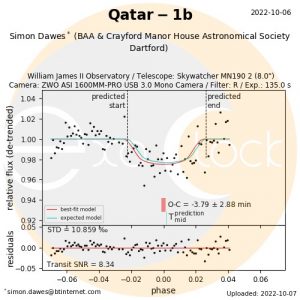
HAT-P-6b was discovered on October 15, 2007. It is located in the constellation Andromeda. It takes 92 hours, 28 minutes, 17 seconds and 9 deciseconds to orbit its host star. The planet HAT-P-6b is named Nachtwacht. The name was selected in the NameExoWorlds campaign by the Netherlands, during the 100th anniversary of the IAU, after Rembrandt's painting The Night Watch. It is one of the few planets that is in a retrograde orbit around its host star.
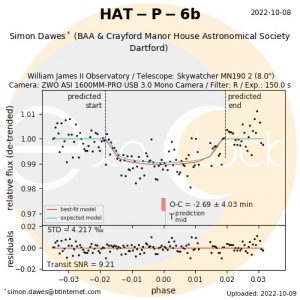
Member Neil Webster has been busy and produced this wonderful image of NGC 6823 & SH-2-86 in the constellation Vulpecula plus a new music video.
SH-2-86 is an H Alpha emitting region (red glow) from the Sharpless Catalogue and NGC 6823 is a small open cluster just above the central dark spike in the image.
Published by Stewart Sharpless in 1959, the SH2 catalogue lists 312 emission nebulae, planetary nebulae and supernova remnants visible in the northern hemisphere. Despite overlapping with deep-sky objects in the Messier and NGC catalogs that are visible to the unaided eye, SH2 is primarily composed of obscure, dim nebulae which can only be revealed through astrophotography.
Neil acquired the image on the 2nd October 2022 using a AA 115mm APO, EQ6-R, ZWO ASI294MC Pro, L EnHance filter, Orion 50mm Guide Scope, ZWO ASI290MM
90 x 140s Lights, 15 x Darks, 30 x Flats/Bias.
APT, PHD
Nebulosity, Photoshop (Camera Raw)
To view a higher resolution image visit Neil's Flickr page at https://www.flickr.com/photos/137388222@N05/
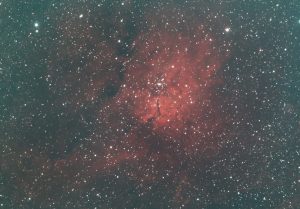
Then sit back and relax and take a tour of the Jellyfish Nebula (IC 443) in the constellation Gemini imaged by Neil whilst listening to a piano based soundtrack. To do so click on the following link The Jellyfish Nebula IC 443 - YouTube where you find Neil's latest music video.
On Friday 30th September 2022 at the ExoClock 2 day meeting held at University College London, CMHASD trustees Martin Crow & Simon Dawes were awarded certificates for their impressive contribution to the ExoClock Project.
ExoClock is a project to monitor the ephemerides of transiting exoplanets by the ARIEL Ephemerides Working Group.
ARIEL is a space telescope (Atmospheric Remote‐sensing Infrared Exoplanet Large‐survey mission) that was selected by ESA as part of its Cosmic Vision plan and is ESA'S next science mission that will focus on the nature of planets orbiting stars in other systems. It will be ESA's fourth medium-class science mission to be launched in 2029.
Both Simon and Martin have contributed over 50 exoplanet observations each to ExoClock and more are yet to come.
Their certificates were presented to them by Anastasia Kokori, Coordinator of the ExoClock project & Professor Giovanna Tinetti, Principal Investigator of the Ariel mission.
Congratulations Martin & Simon. Well done!
Martin Crow receiving his certificate.
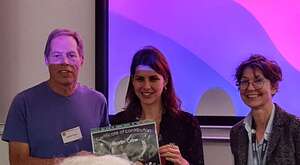
Simon Dawes receiving his certificate.
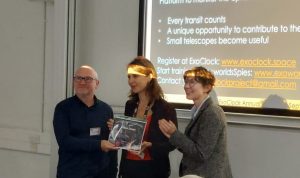
You can view some of Simon & Martin's observations on the CMHASD ExoClock Project page.
An absolutely stunning image by member Kevin Langford of The North America Nebula (NGC 7000 or Caldwell 20). The North America Nebula is an emission nebula in the constellation Cygnus, close to the star Deneb.
ES 102ED APO, 0.7x focal reducer corrector, EQ5 Pro
ZWO ASI071, Orion MMAG,L-eNhance filter
1 1/2 Hrs of exposures
30/08/22
Bexley Kent
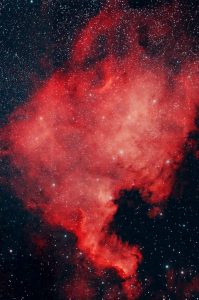
To see a higher resolution photo of the image check out Kevin's Flickr page at www.flickr.com/photos/77708720@N08/52383552499/
One more for the ExoClock Project by Simon Dawes of HAT-P-29b also known as Surt. Surt is the ruler of Muspelheim and the fire giants there in Norse mythology. At Ragnarok, the end of the world, he will lead the attack on our world and destroy it in flames.
See https://www.iau.org/public/themes/naming_exoplanets/
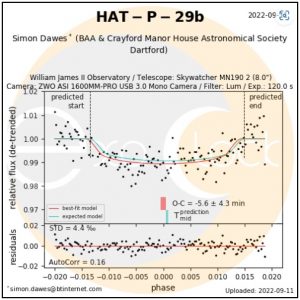
An absolutely fantastic widefield image of the Veil Nebula taken by member Kevin Langford on the 12th August 2022 from Bexley, Kent. The image was acquired using an ES 102ED APO, 0.7x focal reducer corrector, EQ5 Pro, ZWO ASI071, Orion MMAG and L-eNhance filter.
The 3 hours of exposure was then processed in photoshop.
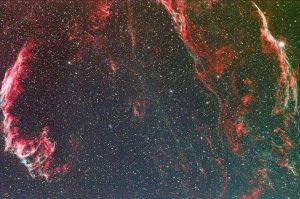
To see a higher resolution photo of this image click on the following link to be taken to Kevin's flickr page https://www.flickr.com/photos/77708720@N08/52321231907/
Taken from a few days ago; this is member Simon Dawes 48th accepted transit for the ExoClock project of exoplanet TrES-3b. TrES-3b is a gas giant exoplanet that orbits a G-type star GSC 03089-00929. It has an orbital period of just 31 hours, is nearly twice the mass of Jupiter and is 0.02282 AU from its star.
The planet TrES-3b is named Umbäässa. The name was selected in the NameExoWorlds campaign by Liechtenstein during the 100th anniversary of the IAU. In the local dialect of southern Liechtenstein, Umbäässa is a small and barely visible ant.
Its discovery was announced in 2007. It is the 3rd transiting planet found by the Trans-Atlantic Exoplanet Survey. It was discovered in the constellation Hercules about 10 degrees west of the star Vega. If you look at the curve you can see that it doesn't have a flat bottom which means from our viewpoint the planet occults the star right on its edge - a grazing occultation.
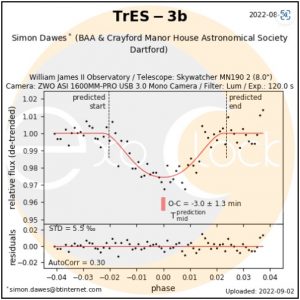
Also measured by Simon is the transit of exoplanet WASP-60b.
WASP-60b orbits at a distance of 8.25 million km from its G1-type star, taking 4.3 days to go round its orbit in the constellation of Pegasus. The system is a distance of 400 parsecs away from us.
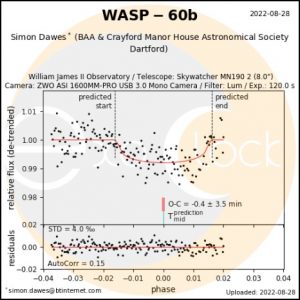
NEVER LOOK AT THE SUN DIRECTLY. Please click here for solar observing safely.
On the morning of the 26th August 2022 member Simon Dawes imaged 3 of the sunspots on the sun - AR3086. AR3088 and AR3089 and superb images they are too. Sunspot AR3088 however looked a little bit different from the usual sunspots seen and indeed it was according to Spaceweather.com - see below.
Details of how Simon acquired the images are on each photo.
Unusual sunspot AR3088
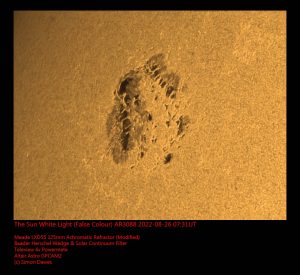
Screen shot from Spaceweather.com explaining why sunspot AR3088 looks unusual....
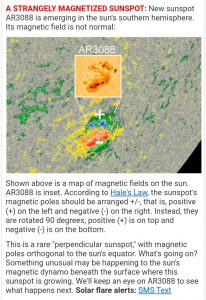
https://www.spaceweather.com/archive.php?view=1&day=25&month=08&year=2022
Sunspot AR3089
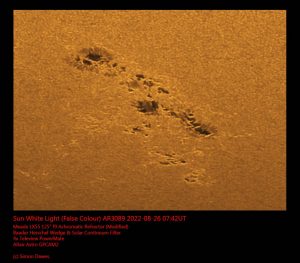
Sunspot AR3086
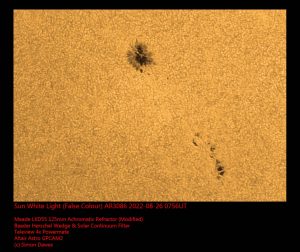
Two absolutely fantastic images of the Moon at 0.01 phase taken by member Jim Burchell on the morning of the 25th August 2022 from Dartford. The second image shows the Moon with Venus on the right.
